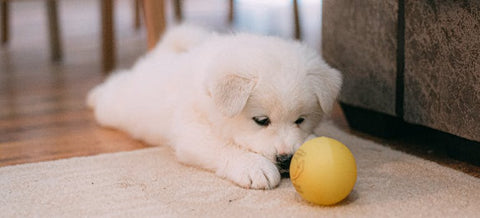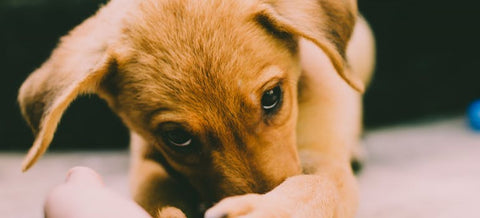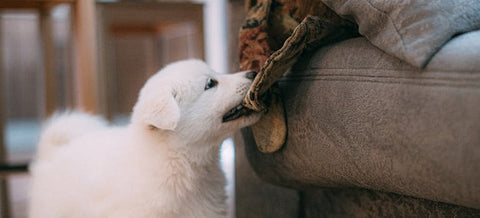Puppy-Proofing Your Home: Ensuring a Safe Environment for Young Dogs
Posted on

Embarking on the journey of puppy-proofing your home is a vital step in welcoming a new, energetic four-legged family member. Young dogs are naturally curious and full of energy. They simply love to explore every corner of their new home with enthusiasm. This exploration, though endearing, can lead to accidents and potential dangers.
Here, we aim to guide you through the various aspects of making your home a secure haven for your new puppy. So, whether you're a first-time puppy parent or looking to refresh your knowledge, let's begin this journey to ensure a safe, puppy-friendly home!
Understand Puppy Behavior
Before making your home cozy for your dog, you need to understand your pup's behavior. Young dogs are bundles of joy, driven by curiosity and the instinct to explore their surroundings. This exploration is often characterized by chewing, sniffing, digging, and sometimes climbing. Recognizing these natural tendencies is crucial in anticipating potential hazards in your home.
By thinking like a puppy, you can identify what might attract or pose a risk to them, from dangling wires to accessible cupboards. Knowing that young dogs often explore the world with their mouths, for instance, helps prioritize safeguarding items they might chew. This knowledge forms the foundation of a well-thought-out plan for puppy-proofing your home.

Caption: Before puppy-proofing your home, you need to understand their behavior
Secure Hazardous Areas
With their boundless energy and curiosity, puppies can easily find themselves in risky situations. However, you can take precautions to create a safe exploration zone for your furry friend, ensuring that their playful discovery of the world around them is as secure as it is joyful.
Key areas to focus on include:
- Kitchens and Bathrooms: Store cleaning chemicals, sharp objects, and small choking hazards in locked cabinets. Ensure trash cans are secure and out of reach.
- Living Areas: Electrical cords should be hidden or covered, and small objects like coins or toys should be kept away.
- Staircases and Restricted Zones: A convertible pet gate is an excellent tool for restricting access to potentially dangerous areas like stairs or rooms with fragile items.
- Bedrooms and Closets: Safely store medications, cosmetics, and small clothing items like socks and shoes.
- Garages and Utility Rooms: Securely store tools, automotive products, and other hazardous materials.
Chew-Proof Your Home
Puppies often explore their world through their mouth, leading them to chew on almost anything they can find. Protecting furniture, electrical cords, and other household items from these playful bites preserves your belongings and prevents your young puppy from ingesting harmful materials. Offering safe alternatives like chew toys or bones is a great strategy. It satisfies a puppy's natural chewing instinct in a controlled and harmless way, redirecting their attention away from household items.
However, some items simply can't be made puppy-proof. In such cases, storing away valuable or dangerous items becomes necessary for your dog's safety and the preservation of your belongings. In this case, renting a storage unit can be incredibly beneficial. It offers a secure space to keep such items until your puppy matures and learns what is unsuitable for chewing. In addition, a storage unit provides a clutter-free environment in your home, reducing the risk of accidents and making it easier to monitor and train your puppy in a safer, more controlled setting.

Caption: Young dogs love to explore and chew
Create a Puppy-Safe Living Space
Creating a safe living space balances comfort and safety, ensuring your home is a secure, enjoyable environment for your new furry friend. Start by rearranging furniture to minimize the risk of accidents – sharp corners and unstable items should be out of reach or secured. Opt for dog-friendly furniture and fabrics that can withstand rough handling and are easy to clean.
It’s equally important to designate a specific space for your puppy, like a cozy bed or crate, where they can feel safe and relaxed. This dedicated space gives them a sense of security and helps manage their behavior by creating clear boundaries within the home. Crafting such a living space will nurture their well-being and help them integrate smoothly into your household.
Toxic Substances to Keep Out of Paw’s Reach
When puppy-proofing your home, keeping toxic substances out of the paw's reach is critical to safeguard your dog's health. Common household items can pose serious risks, so awareness and preventive measures are key. Here's a list of toxic substances to be mindful of:
- Cleaning Products: Store all cleaning agents in locked cabinets or high shelves, including laundry detergents and disinfectants.
- Human Medications: Ensure all prescription and over-the-counter medicines are securely stored away from where your puppy can access them.
- Certain Plants: Many common houseplants, like lilies and aloe vera, are toxic to dogs. Research and remove harmful flora from your home.
- Foods: Items like chocolate, grapes, onions, and xylitol-containing products must be kept out of reach.
- Pesticides and Rodenticides: Securely Store pest control substances and use them cautiously.
Puppy-Proofing Your Yard
Puppy-proofing your yard ensures your young dog's safety when they venture outdoors. It's important to start by securing the perimeter with sturdy fencing to prevent escapes and protect your puppy from external hazards. Inspect the yard for any holes or weak spots in the fence where a curious puppy might try to squeeze through or dig under.
Additionally, removing dangerous plants and ensuring that your garden is free of toxic foliage is crucial. Consider creating a designated play area where your puppy can enjoy the outdoors safely. This space should be clear of debris, harmful chemicals, or sharp objects. That way, you create a secure outdoor environment where your puppy can play and explore without risk, giving you peace of mind.

Caption: Your yard should be as safe as your home
Training and Supervision
Consistent supervision is crucial, especially in areas of your home that haven’t been fully puppy-proofed. This vigilant oversight helps prevent accidents and provides opportunities to correct unwanted behaviors gently. Meanwhile, for instilling good habits and obedience, essential for a puppy's safety and well-being. Training teaches puppies what is off-limits and helps them understand boundaries within the home.
It also strengthens the bond between you and your puppy, fostering a relationship based on trust and understanding. Combining effective training with attentive supervision creates a safe and structured environment conducive to your puppy’s healthy development.
A Safe Haven for Your Furry Friend
Puppy-proofing your home is necessary for ensuring the safety and well-being of your young dog. With patience, consistency, and the right approach, you can create a secure and loving environment for your puppy to grow and thrive. Share your experiences and tips to help fellow puppy parents on this rewarding journey.
✍🏼 Natalie Taylor
